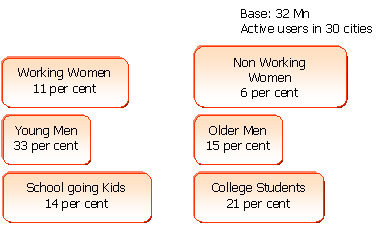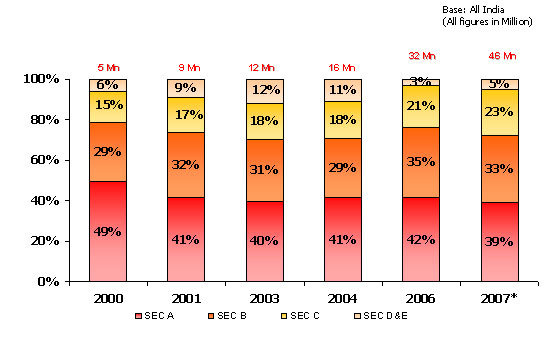|
Mumbai: Only 39 per cent of internet users belong to the socio-economic classification (SEC) A, down from 49 per cent in 2000, says a report by Internet in India (I-Cube) jointly undertaken by the Internet and Mobile Association of India (IAMAI) and IMRB International. The report also pointed out that during the corresponding period the share of SEC C has gone up from 15 per cent to 23 per cent. ''The findings of the report prima facie suggests that the internet user base is becoming more equitable,'' said Dr Subho Ray, president, IAMAI, ''However, it would not be correct to oversimplify the trend since there has been a steady decline in SEC D and E from 12 per cent in 2003 to 5 per cent in 2007''. Socio-economic classification (SEC) indicates the affluence level of a household to which an individual belongs. Socio economic classification of an urban household is defined by the education and occupation of the chief wage earner (CWE) of a household. SEC is divided into 8 categories A1, A2, B1, B2, C, D, E1, and E2. (in decreasing order of affluence). I-Cube 2007 survey covers all the SECs in top 8 metros and SEC A, B and C in other centers. 
In another significant demographic development, the report confirmed once again that internet unfortunately continues to be ''male dominated'' with ''young men'' accounting for an overwhelming 33 per cent and ''older men'' accounting for 15 per cent of internet users. The overall demographic trend continued to favour the youth with college students and school going users accounting for 21 per cent and 14 per cent of total users. According to Mohan Krishnan, senior vice president, IMRB and country manager, BIRD, IMRB, 'it was unexpected and unfortunate that the share of non-working women and older men had declined over the previous year. He added that this decline may have been due to higher growth rates in the other segments. The report used the following demographic categories:
School Kids: All those studying in school above 8 years of age. Most students will be in the age group of 8-17 although a small proportion will be over 18 years.
College Going: All those studying in college (graduate, post-graduate and doctoral). Most students will be in the age group of 18-23 although a proportion will be below 18 and over 23 years.
Young Men: These are men in the age group of below 35 years who are not school or college student. This segment includes all those who are employed as well as unemployed.
Older Men: These are men in the age group of 35 to 58 years and include all in this age group whether employed or not.
Working Women: These are women in the age group of 18years to 45 years and employed outside home.
Housewives: These are women below 45 years age and not working. This segment includes housewives as well as non-working young women who are not school or college students. 
(Also See: 41 per cent of Internet users are from ''smaller'' towns)
|